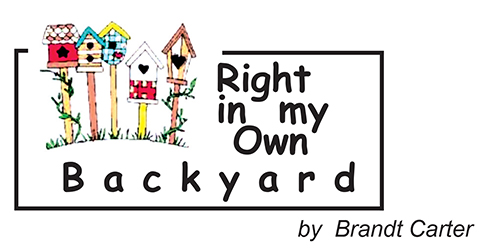
|
Broad Ripple Random Ripplings

The news from Broad Ripple
Brought to you by The Broad Ripple Gazette
(Delivering the news since 2004, every two weeks)

|
| Brought to you by: |

|

|

|

|

|

|
Converted from paper version of the Broad Ripple Gazette (v13n11)
Right in my Own Backyard - Beginning Birdwatching 1 - by Brandt Carter
posted: May 27, 2016

Beginning Birdwatching 1
Many of you sit on the patios of the Broad Ripple restaurants and enjoy the outdoors or walk the Monon Trail and streets of the village. You may see a quick movement or here a cheerful birdsong without knowing what the creature is that distracts your attention. This is the first column about birds you might see in Broad Ripple.
American Robin

image courtesy of Bob Moul
American Robin The American Robin is a very common lawn bird that you can see on the lawns, gardens and parks in Broad Ripple. In the spring, summer, and fall you may catch of glimpse of them looking for worms on the grounds. Later in the day, you may sight them in berry bushes or fruit trees. They may have up to three broods a season, and most of us can identify their egg color-robin's egg blue. In winter you may spot them in groups but sitting in trees more than the ground.
The robin's song is a string of 10 or so clear whistles made up of a few repeated syllables, and often described as cheerily, cheer up, cheer up, cheerily, cheer up. Yes, they are here all year. Normally you will not see them at your birdfeeder, and they will not nest in a birdhouse you may put out.
Sparrow

image courtesy of Bob Moul
Sparrow "His Eye is on the Sparrow" is a beautiful song about the importance of the least significant. The sparrow is proliferous, and there are many species that may even cause the best birdwatcher to hesitate before identification. They are the "little brown bird" that will grab a crumb from the patio floor of one of our restaurants.
They are ravenous seed eaters emptying a feeder in no time flat. Sparrows are also opportunistic birdhouse dwellers often pecking out the hole of a wren house so they take over the house. They are intruders in bluebird house and often have to be evicted by force. Although there are at least 35 types of sparrow species in North American, you should be able to ID these in no time flat.
Starling or Grackle

image courtesy of Bob Moul
Starling or Grackle The Starling and Grackle are two of the "black birds" you might see. They are by far my least favorite birds. These rascals are raucous, ravenous, and often bullies.
Starlings have a short tail and longer, slender bill. In the winter starlings have a highly speckled, iridescent coat, while in the summer their plumage is much duller brown/black with less speckles. Only 100 of these birds were released in Central Park in late 1800's, and now there are estimated well over 200 million.
Grackles have glossy or iridescent feathers, usually all black. Grackles are also less chunky than starlings and have longer tails and a sleeker build. Their beaks are dark in winter and yellow in summer, and they have black eyes with a yellow ring.
They both do a lot of walking on long legs in search of insects and just about anything they can find including garbage. They do not nest in birdhouses but they will visit both suet and seed feeders, especially when there is snow cover. There are solutions for keeping them from your feeder.
Chickadee

image courtesy of Bob Moul
Chickadee This bird is not only dainty and fairy-like but its song is its name. If you hear the "chick-a-dee-dee-dee", you will know the bird is about. We have both black-capped and Carolina Chickadees, and I don't distinguish. They are usually the first to find a new feeder and seldom remain at feeders except to grab a seed to eat elsewhere. They are acrobatic and their flight is bouncy. They will eat suet, sunflower, and peanuts.
Most birds that associate with chickadee flocks respond to chickadee alarm calls, even when their own species doesn't have a similar alarm call. They will nest in nest boxes.
Northern Cardinal

image courtesy of Bob Moul
Northern Cardinal Our state bird, the Northern Cardinal, is probably the easiest to spot because of his color. The cardinal's notable song "Cheer up, Cheer up, Cheer up" or a second one, "Chip, Chip, Chip." can be learned quickly. You will learn the female is not red but a dull tan with reddish tinges. They enjoy seeds at birdfeeders like sunflowers, peanuts, and safflower. The nest in the open so they will not use any birdhouse you may hang.
The cardinals prefer to hang out in dense shrubs and tangled branches, The males will defend their zone from intruders and can be seen fighting their reflections in a window or car mirror. Seven states, including Illinois, Indiana, Kentucky, North Carolina, Ohio, Virginia and West Virginia claim cardinals as their state bird. It is also the mascot for countless sports teams including Ball State.
I hope by the next column you have spotted all five of these birds. You should be able to do this even through the window at McDonald's. If you do, share your new skill with a young friend. This way we can be better in touch with nature and those birds that inhabit Broad Ripple.
Permission was granted by Bob Moul to share his photos with my readers.
Brandt Carter, artist, herbalist, and naturalist, owns Backyard Birds at 2374 E. 54th Street. Visit her web site www.feedbackyardbirds.com. Email your bird questions to Brandt@BroadRippleGazette.com
brandt@broadripplegazette.com

|

|

|
| Brought to you by: |

|

|

|
| Brought to you by: |

|

|

|


